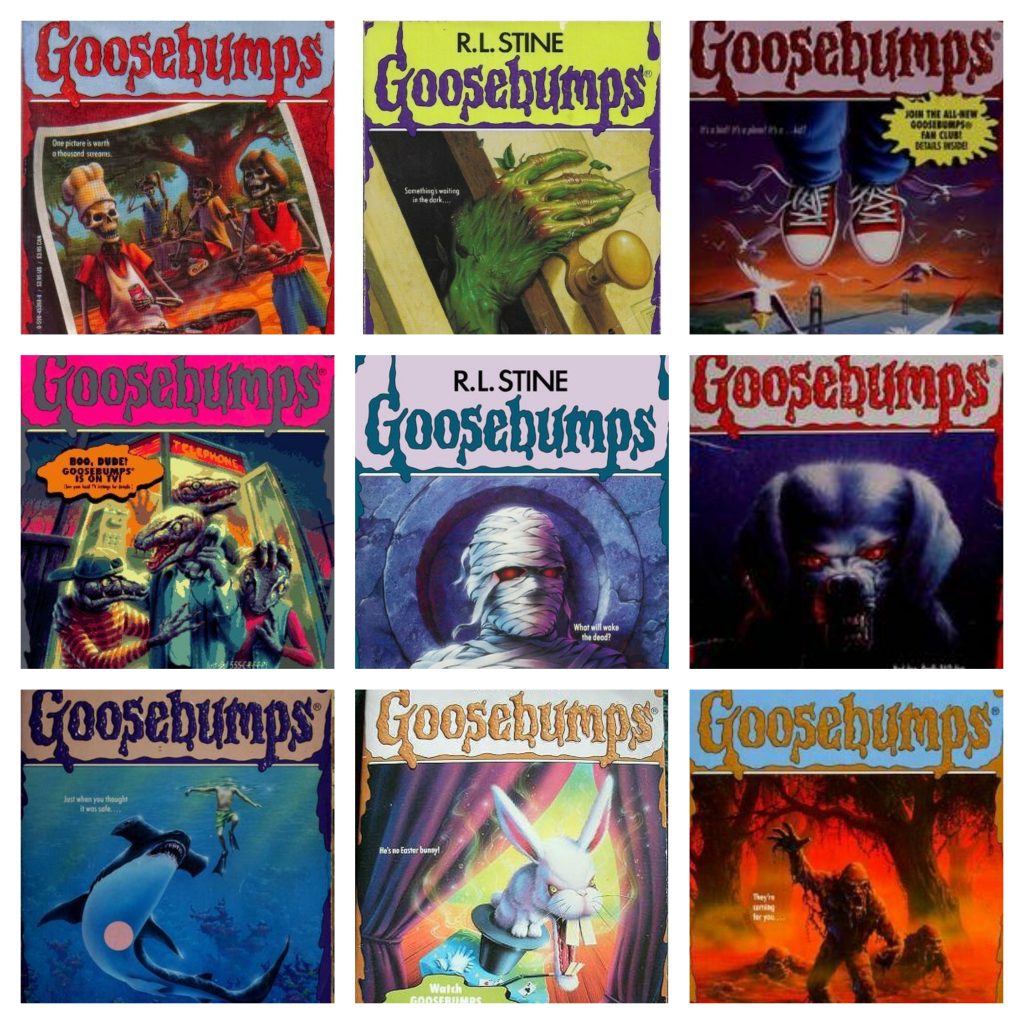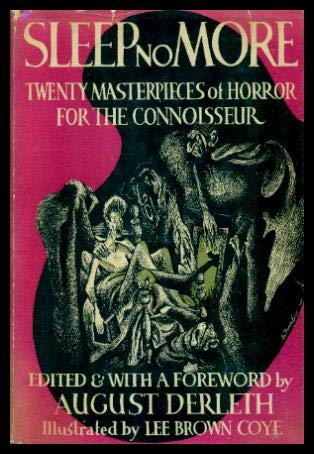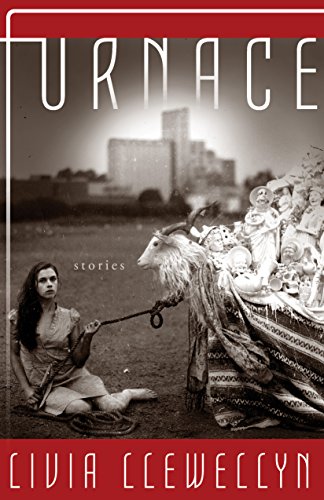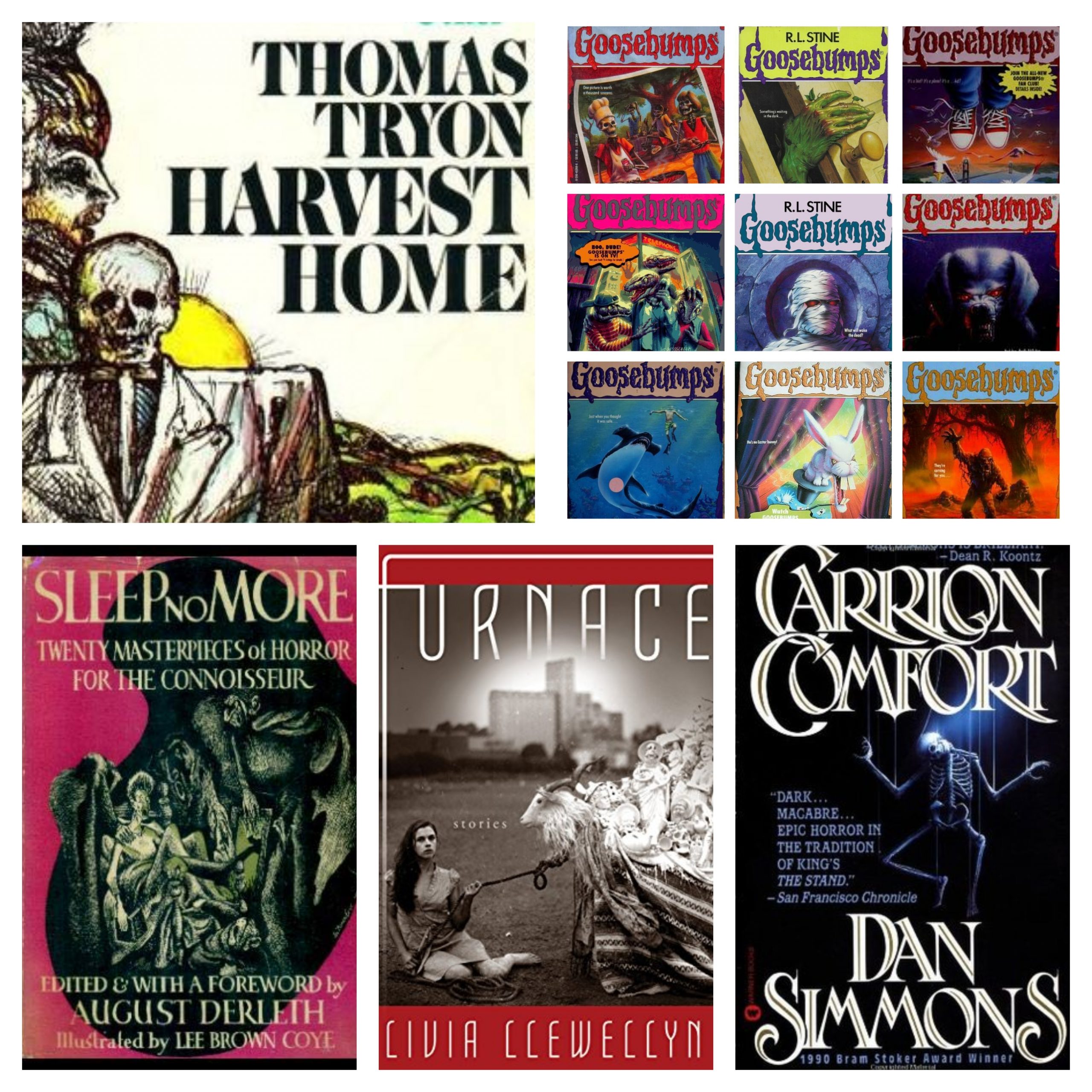Since it’s creepy season in October, I thought I’d slide one more of these in before the end of the month. This time I’ve got a classic of the folk horror genre, yet even more doofy Goosebumps, a collection of Weird Tales, a collection of REALLY weird friggin’ tales and an epic of ’80s action horror involving mind-controlling energy vampires.
For those just joining me, this is my journey through the following “Best of” Horror lists:
Reedsy Discovery Best Horror Books
Stephen Jones & Kim Newman’s Horror: 100 Best Books
Stephen Jones & Kim Newman Horror: Another 100 Books
If you want to check out my previous entries, they can be found here:
Part 31 | Part 30 | Part 29 | Part 28 | Part 27 | Part 26 | Part 25 | Part 24 | Part 23 | Part 22 | Part 21 | Part 20 | Part 19 | Part 18 | Part 17 | Part 16 | Part 15 | Part 14 | Part 13 | Part 12 | Part 11 | Part 10 | Part 9 | Part 8 | Part 7 | Part 6 |Part 5 | Part 4 | Part 3 | Part 2 | Part 1
Niceties aside, let’s dive in!

Harvest Home (Thomas Tryon, 1973)
List: Jones/Newman
Ned and Beth, tired of big city living and with their teenage asthmatic daughter Kate in tow, move to the small town of Cornwall Coombe. The residents have some odd customs surrounding a big harvest festival, but it all seems harmless and they are all very friendly, particularly the widow fortune, a sort of matriarch of the village who most notably earns Ned’s and Beth’s trust when she saves their daughter’s life after a particularly severe asthma attack. Beth and Kate immediately begin to embrace the village’s ways, with Kate falling for a local boy named Worthy who begins to balk at the village’s customs. Ned meanwhile is skeptical by nature and despite making friends among the villagers still questions some of their beliefs and some of the mysterious occurrences that have happened in the past in Cornwall Coombe, especially around the mysterious death a girl named Grace Everdeen. Will Ned come to embrace Harvest Home and make peace with the villagers or will he become entrenched in dark secrets, terrifying rituals and the worst horrors mortal man can witness? I mean, you should know the answer given this book is on a Best Horror list.
I’ve been looking forward to getting to this one given how much I ended up liking Tryon’s The Other as well as generally being a fan of folk horror. Harvest Home very much follows the template set forth by the likes of The Wicker Man or the recent Midsommar of the skeptical outsider who attempts to discover the dark secrets of a small, insular community but is confronted by the deadly rituals firsthand. The book certainly takes its time, giving the read a very crisp and clear sense of the daily life of Cornwall Coombe, explaining their ways, their beliefs, developing many of the individual citizens in a more three-dimensional way than some inferior variations on this story I’ve seen that tend to simplify the community into paper thin religious zealots. We see people like Worthy, local bell-ringer Amys and former college professor Frank Dodd who Ned befriends who offer viewpoints beyond earnest obedience to the will of the corn or who feel like real people that see the community for what it is. If the book has a fault, it’s that it may take too long in developing out the community of Cornwall Coombe before introducing the horror elements of the story. It really isn’t until the third act before truly sinister occurrences begin to crop up beyond nearby violent moonshiners. Despite that though, the book does introduce some mysteries that held my interest like what happened to Grace Everdeen. I do think the climax of the book works pretty well though in offering a kind of slow burn accumulation of dread and horror and the denouement is actually quite chilling in its implications. Overall, while Harvest Home’s first half certainly could’ve been trimmed a little for editorial efficiency, it’s still a quite good folk horror trip that’s worth checking out for those willing to exercise a little patience.

Goosebumps Round-Up #4
I gotta say, these Goosebumps books aren’t getting any easier to read. Also why is it that so much kid-lit has unlikable main characters? They’re either self-absorbed assholes like in Diary of a Wimpy Kid or stupid and/or whiny like 80% of the main characters in Goosebumps books. Do kids just like feeling superior to their protagonists? Anyway…
Stay Out of the Basement: This one involves a couple of kids whose dad is doing weird plant-based experiments in the basement, and they’re desperate to discovery what it’s all about. This was the second Goosebumps release and I guess it’s kind of Stine’s version of a pod people story, complete with the cheesy “No! I’m the real one” “No! I’M the real one!” face off. The ending was also lame, taking the path of least resistance.
Say Cheese and Die: Some kids break into a house and steal an old camera (see what I mean about asshole protagonists?) that has the strange power of taking photos of disasters to come. This one got pretty damn frustrating due to the stupidity of the main character. After being shown over and over and over again that taking pictures with that camera causes horrible things to happen, it takes him FAR too long to decide to get rid of it. And instead of trying to destroy it or bury it, he makes the stupid decision to break BACK into the big, scary old house with the crazy guy living in it to put the camera back. Whatever interesting ideas this might’ve had gets buried in stupid.
The Curse of the Mummy’s Tomb:. You know, this is actually one of the better Goosebumps books I’ve come across despite nearly the entire book being non-supernatural. The kids in it largely don’t act like huge dumbasses (other than the protagonist’s extremely frustrating habit of needing to tie his shoe at the most inopportune times possible) and the book creates a fairly interesting story for kids to introduce them to the world of spooky Egyptology.
You Can’t Scare Me: This gets annoyingly repetitive and predictable really fast as our main characters try and fail to scare a tough-as-nails girl at school over and over again. This is another one with barely any supernatural element to it like Mummy’s Tomb but really suffers from a lack of ideas.
Deep Trouble: This one isn’t even a horror story save for a couple of brief moments involving a kraken. Most of this one is basically Free Willy with a mermaid. Very lame. Very boring.
The Barking Ghost: This one about a constantly terrified kid with an asshole brother who happens to live next to some spooky woods with ghost dogs roaming around in it is a messy jumble of ideas that never really comes together, eventually settling into a “Why I’m Afraid of Bees” variant. Not exactly that predictable but still pretty lame.
Bad Hare Day: Having just read Peter Straub’s excellent Shadowland, any Goosebumps story that attempts to tackle the darker side of magicians is gonna come across as even more of total dog shit in comparison. We also have yet another one that ends with a lame “Why I’m Afraid of Bees” style riff.
The Beast from the East:. This one about some kids who end up in a deadly game of tag in the woods with monstrous creatures is frustrating and stupid. I feel like Stine farted this one out in a weekend after playing tag with his nephew or something.
How to Kill a Monster: Hey kids, don’t open that mysterious door. Oh shit, you opened it? Welp, I guess you’re screwed. Why did it take them so long to read that second letter? Another frustrating one that at least doesn’t mess around being coy and lame for most of its duration.
Calling All Creeps: A picked on kid plants a dumb message “Calling all creeps” in the school newspaper with what he thinks is his bully’s phone number but ends up being his own when the bully finds out and switches numbers before going to print. Now the kid is getting calls at all hours of the night from monsters called creeps asking when the revolution will begin. Extremely thin premise even by Goosebumps standards.
How I Learned to Fly: The protagonist is yet another in a long string of Goosebumps main characters with a severe inferiority complex, constantly bested by another more popular kid in his neighborhood.He thinks he’ll finally beat him in the oneupmanship game when he discovers a book with a magic powder in it that lets him fly, but of course due to some lazy writing, the more popular kid ALSO learns to fly. While most of this one was pretty weak, repetitive and predictable, I was a little surprised at the emotional maturity of the ending, at odds with 99% of Goosebumps endings that seem to want to pull off a cheesy B-movie style twist at the end.

Sleep No More (Edited by August Derleth, 1944)
List: Jones/Newman
Vaunted cheerleader of weird fiction August Derleth puts together the first of many horror anthologies celebrating the new school of weird fiction (at the time, that is) made popular by the likes of H. P. Lovecraft, Clark Ashton Smith and Robert E. Howard (all of whom are included here). The stories in this collection largely pull from Weird Tales magazine and a few other pulp magazines of the era rather than draw from the usual pool of 19th century authors like Poe, de Maupassant, Crawford, etc. We do get stories from what are considered some of the elder statesmen of weird fiction like M. R. James (with his great vampire story “Count Magnus”), Algernon Blackwood and Robert W. Chambers with his story “The Yellow Sign” from his collection The King in Yellow, a major influence on Lovecraft’s Cthulhu mythos. We’ve seen all these guys in collections before, so while their inclusions are nice, they aren’t necessarily revelatory. The same goes for Lovecraft’s “Rats in the Walls” that the collection ends on. It’s a very good story (despite the unfortunate cat name) but it’s found in many anthologies. Some of the highlights for me are weird fiction authors that I don’t see anthologized as much like the lurid and fun Frank Belknap Long, the grim and violent Maurice Level (whose “The Kennel” here is just mean), an early story from H. Russell Wakefield and future Psycho author Robert Bloch. It was also pretty cool to see Clark Ashton Smith and Robert E. Howard contributing stories within the Chthulhu mythos.
As far as the stories that didn’t really grip me, M. P. Schiel’s overly ornate “The House of Sounds” and the somewhat shapeless “Two Black Bottles” co-(ghost)written by Lovecraft were among the few. Overall though, I generally dig these deliciously pulpy tales that Derleth has gifted us with and looking forward to digging into more of them with Derleth’s other collection on this big horror list The Sleeping and the Dead (as well as many others I’ll probably check out at some point).

Furnace (Livia Llewellyn, 2016)
List: NPR
Livia Llewellyn brings forth a dark, strange and sexually deviant collection of thirteen stories of ornate and decadent majesty. Llewellyn’s stories are full of big, grotesque and highly creative ideas in a widely diverse style of storytelling. Some are almost stream of conscious with words swirling about, gnashing and tearing, stripping down into a thick and viscous goo. One is written as a series of Craiglist exchanges that grow increasingly bizarre and disturbing. One of the best stories in the collection “The Last, Clean, Bright Summer” is written as a series of diary entries, detailing a truly horrifying and strange coming-of-age ritual involving a giantess emerging from the sea and birthing rape creatures, packaged as an eery slow burn folk horror. “Allocthon” is another really good one, a kind of Groundhog Day style story of a slow-coming revelation of a cosmic monstrosity. “Stabilimentum” is one of the few in the collection without a strong erotic slant to it and is a humdinger of a story for those who suffer from arachnophobia.
I have mixed feelings on this one, but it’s a collection that has moments stuck in my mind of particular impact. Llewellyn’s writing style can at times come across overly pretentious and difficult to parse with a lack of punctuation and a way with words that often intentionally misleads or obfuscates what it happening. In fact, “The Last, Clean, Bright Summer” with its diary style is the only really straightforward story in the whole book. Some of them I actually found myself re-reading passages from to get a more firm understanding of what was happening, and when I actually took the time, I found some of the stories more intriguing and fascinating. Furnace is a collection that may require revisiting to appreciate more fully. Having said that, there were a couple of stories that just felt like well-written erotic fan fiction and really didn’t strike me as that great regardless. Overall though, if you’re patient and craving something extremely weird and willfully confusing and creepy, this may scratch that particular itch.

Carrion Comfort (Dan Simmons, 1989)
Lists: Reedsy Discovery, Jones/Newman
Nine dead in the same area, seemingly unrelated but with an undercurrent of some unperceived connection. Law enforcement is befuddled, even more so by the presence of the FBI for what seems like a local string of homicides. Sheriff Bobby Joe Gentry (his friends call him Rob) in particular knows there’s something more to this bizarre sequence of events that what the Feds are proposing. Natalie Preston is a young, black photographer whose father was killed in the strange murder spree and wants answers. The man who has some answers is Dr Saul Laski, pulled into the investigation due to his having had as a client one of the murder victims. Laski is a holocaust survivor who knows the secret of super-powered people with the ability to control other people’s minds and sap their energy for their own youthful vigor. One of these mind vampires was a particularly cruel and devious SS officer that tormented Saul in the concentrate camps from which he escaped, subjecting him to a humiliating and deadly game of human chess. This officer and two other women they come to find were at the center of this string of murders and have been periodically meeting with one another every few years in a kind of game to see who has indirectly killed the most people. Time has worn down their fondness for one another however and thus the series of murders is the fallout. As Laski, Natalie and Rob start digging however, they find that a much bigger conspiracy is at the heart of what’s happening, and they are merely pawns in a global game of deadly chess between shadowy and deviant figures in the upper echelon of the powerful elite.
Damn, this was long… Honestly while it did feel pretty broad-sweeping and epic in places, I think it could have been compressed a little. Also while there are some horrific moments of cruelty and violence here, it’s the books huge and impressive action set pieces that leave a lasting mark. While Carrion Comfort is marketed as a horror novel, those who like to sink their teeth into a juicy conspiracy thriller will find much to chew on as they warring mind vampires seek to annihilate one another and anyone who gets in their way. Simmons definitely has a firm grasp of how to write compelling action even as he stumbles a little during some of the exposition sequences. Some of the dialogue also comes across a little clunky, but in general it’s still much better than the cheesy junk someone like Dean Koontz would churn out. Conceptually this book is swinging for the fences and for the most part it really does attain a feel of massive and far-reaching scope. I particularly appreciated the structure of the novel and how it starts out more localized and gradually gets more and more broad rather than throwing you straight into the deep end and hope you don’t drown (which is a pet peeve of mine with a lot of conspiracy/espionage thrillers that get mired too soon in shadowy doublespeak and convoluted entanglements). Overall I think Simmons has created a pretty effective action horror page turner that, while it could have been at least a hundred pages shorter and not really suffered much, delivers on what it promises.

